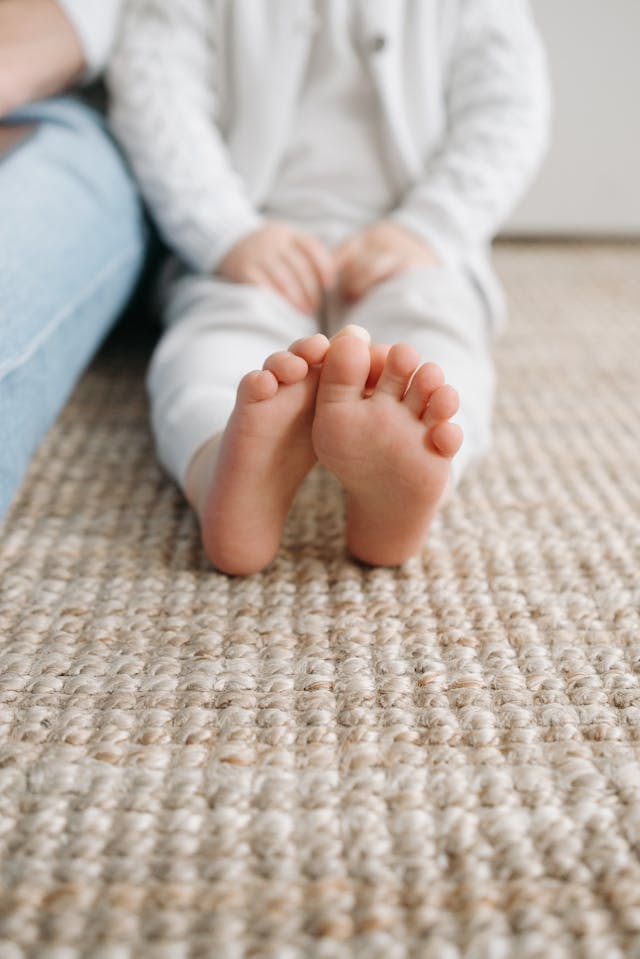Caring for our children’s feet can often be a source of concern, can’t it? They grow so fast, making proper foot care crucial. Ignoring those little feet can result in issues like flat feet, alignment troubles, or general discomfort. Rest assured, you’re not alone in this! This article will guide you through the essential steps to ensure your children’s feet remain healthy and happy from infancy through their teenage years.

Proper foot care is a vital component of your children’s overall health. For specialized treatment of foot and ankle conditions in children and adolescents, consider consulting a specialized Foot Ankle & Leg Vein Center, which offers comprehensive podiatric services. They provide expert diagnosis and treatment for a variety of foot issues, ensuring your child’s feet receive the best care possible.
The Basics: Understanding Foot Development
Those adorable little baby feet are mainly composed of cartilage, which gradually turns into bone. Growth plates remain sensitive to pressure and injury until adolescence, underscoring the importance of proper support and care.
“A child’s foot is not simply a smaller version of an adult foot,” says Dr. Emily Carter, a pediatric podiatrist. “The flexibility and rapid growth of children’s feet necessitate specific attention to footwear and timely intervention if any issues arise.”
Foot Care Through the Years: An Age-by-Age Guide
Here are key foot care tips tailored to each age group.
Infants (0-12 months): Letting Those Toes Wiggle
Barefoot time is best for babies! Allowing them to kick and wiggle helps their muscles develop naturally. If needed, choose soft, flexible socks or pre-walker shoes.
- Warning Sign: Look out for clubfoot or curling toes. Consult your pediatrician if you have concerns.
- Real Parent Tip: “I noticed my baby’s toes were a bit curved. The pediatrician suggested gentle stretches, and they straightened out within a few months!” – Sarah M.
Toddlers (1-3 years): Exploring the World on Their Feet
Toddlers are constantly in motion. Allow them to walk barefoot indoors to strengthen their foot muscles. Outdoors, opt for soft-soled, flexible shoes that promote natural movement.
- Warning Sign: Be alert for persistent toe-walking or in-toeing (feet turning inward).
- Activity Idea: Create a mini obstacle course with various textures like carpet, blankets, and pillows to encourage diverse foot movement.
Preschool & Early Childhood (4-7 years): Rapid Growth
Growth spurts necessitate frequent shoe size checks (every few months!). Teach your child about good foot hygiene by washing and drying their feet daily.
- Activity Idea: Set up a “foot spa” with warm water and gentle soap, allowing them to scrub their feet with a soft brush.
- Shoe Shopping Tip: Involve your child in selecting shoes that fit properly and are comfortable.
School Age (8-12 years): Laying the Foundation
Improperly fitting shoes can affect posture and even the spine. Watch for signs like flat feet, heel pain, or limping.
- Product Recommendation: Consider cushioned socks for added comfort during sports; brands like Nike and Adidas offer excellent options.
- Cost Consideration: Expect to spend around $10-20 for a pack of quality athletic socks.
Teenagers (13-18 years): Preparing for Adulthood
As teens often experience growth spurts, their feet can change rapidly. Ensure they have suitable footwear for both sports and daily activities to avoid injuries. This age group is also susceptible to athlete’s foot, bunions, or plantar fasciitis.
- Troubleshooting: For athlete’s foot, over-the-counter antifungal creams can be effective. Consult a podiatrist about shoe options for bunions.
- Real Parent Experience: “My daughter complained of heel pain during soccer practice. It turned out to be plantar fasciitis. With supportive shoes and stretching, she was back on the field in a few weeks!” – Mark L.
Selecting the Right Shoes: A Step-by-Step Guide
- Measure Both Feet: Children’s feet aren’t always the same size.
- Consider Foot Shape: Make sure to choose shoes with an appropriate width for wider feet.
- Activity Matters: Remember that running shoes differ from casual ones.
- Avoid Hand-me-Downs: If possible, refrain from passing down shoes as they mold to the previous owner’s foot.
- Look For: Good arch support, flexibility, and breathable materials.
Common Foot Issues: Knowing When to Seek Help
- Flat Feet: Feet lacking arch while standing.
- Ingrown Toenails: Painful nails growing into the skin.
- Warts: Contagious growths caused by viruses.
- Overpronation: Excessive inward rolling of the foot when walking.
For minor issues, warm water soaks or over-the-counter treatments might be effective.
Consult a podiatrist if:
- Your child is experiencing significant pain.
- The problem seems to worsen.
- You’re unsure of the appropriate treatment.
Making Foot Care Fun: Establishing a Routine
- Hygiene Routine: Encourage washing, drying, and trimming nails regularly.
- Foot Exercises: Try activities like picking up marbles with toes, walking on tiptoes, or performing heel raises.
- Communication: Foster open dialogue about foot pain with your child.
The Role of Orthotics: Insights from Dr. Jennifer Lee
“Orthotics can be tremendously helpful for children dealing with certain foot issues,” states Dr. Jennifer Lee, a pediatric podiatrist. “Conditions like severe flat feet, excessive pronation, or anatomical abnormalities can often be effectively managed with the right orthotic support.”
- Custom vs. Over-the-Counter: Dr. Lee notes that custom orthotics, designed specifically for a child’s feet, tend to be more effective than mass-produced alternatives.
- When to Consider Orthotics: Common reasons to think about orthotics include:
- Chronic foot pain
- Uneven wear on shoes
- Frequent tripping or clumsiness
- Diagnosed foot conditions
“The price of orthotics can vary significantly,” Dr. Lee explains. “You might find over-the-counter solutions ranging from $30 to $75, while custom orthotics can be several hundred dollars. It’s crucial to consult a podiatrist to determine the best option for your child.”
Case Study: Emily’s Journey with Flat Feet
Seven-year-old Emily was diagnosed with flexible flat feet, which caused her considerable discomfort during physical activities. Her mother observed that Emily frequently complained of aching feet after playing and that her shoes were wearing out unevenly.
- Initial Consultation: A podiatrist examined Emily’s feet and confirmed the diagnosis, recommending custom orthotics for arch support and gait correction.
- Results and Treatment: After consistently wearing the orthotics for six months, Emily reported significantly less pain, and her mother noticed improved shoe wear.
- Ongoing Care: Emily continues to wear her orthotics during activities and attends regular check-ups to monitor treatment effectiveness.
Seasonal Foot Care Tips: Year-Round Considerations
- Summer: Focus on breathable sandals and foot protection at pools or beaches to stave off fungal infections. Encourage barefoot play in safe areas like grass.
- Winter: Ensure boots provide a snug fit and insulation without being overly tight. Encourage children to remove their boots indoors to prevent excessive moisture buildup.
- Fall and Spring: Promote the use of breathable socks during sports and outdoor activities.
Final Thoughts
Proactive foot care—including appropriate footwear, regular foot examinations, and maintaining good hygiene—can greatly enhance your child’s overall well-being. By staying attentive to their feet and encouraging them to be mindful, you can help prevent issues and ensure they enjoy a lifetime of healthy, happy feet!
About Outoftownblogs
Be sure to explore all posts by Outoftownblogs and subscribe via RSS or EMAIL so you don’t miss any updates!





